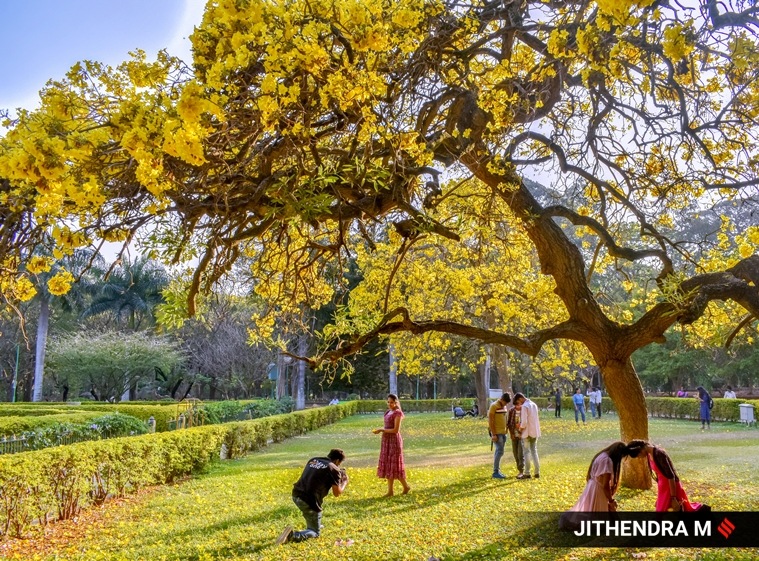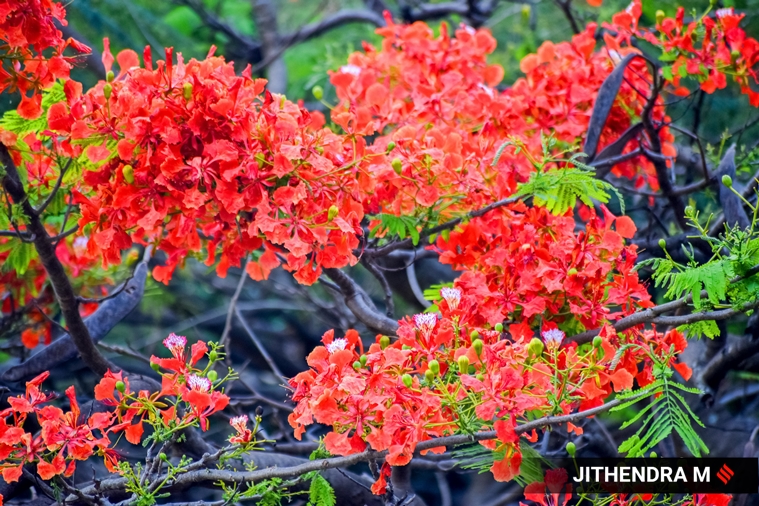📣 For more lifestyle news, click here to join our WhatsApp Channel and also follow us on Instagram
Bengaluru painted in colourful hues as flowers bloom across the city
While the city is popular for its greenery, photographers and netizens await the time when the city dons different hues.
 Several trees bloom around this time of the year across the 'Garden City'. (Express Photo by Jithendra M)
Several trees bloom around this time of the year across the 'Garden City'. (Express Photo by Jithendra M)Every year, with the season changing from spring to summer, Bengaluru is smeared with shades of pink, yellow, red, and white. With the trees blooming around this time of the year across the ‘Garden City’, the landscape presented by the metropolis is a visual treat.
While the city is popular for its greenery, photographers and netizens await the time when the city dons different hues. Several videos and photographs of the city adorned in a myriad of hues are shared on social media every year.
A lion’s share of this ‘beautification’ is attributed to the Tabebuias trees. The evergreen Tabebuias is a blooming tree, with its flowers turning pink during the winter season and yellow in summer. It is also known as the ‘Golden Shower’ or the ‘Tree of Gold’ due to its impeccable golden hue that is reminiscent of the golden sunset hours.
 The ‘Golden Trumpets’, with its flowers, are reminiscent of the golden hours of sunset. (Express Photo by Jithendra M).
The ‘Golden Trumpets’, with its flowers, are reminiscent of the golden hours of sunset. (Express Photo by Jithendra M).
Predominantly found in Jayanagar, Lalbagh, Cubbon Park, and parts of south and central Bengaluru, the yellow Tabebuia is native to South America in Suriname, Brazil, eastern Bolivia, Peru, Paraguay, and northern Argentina. It blooms in Bengaluru between March and April.
Tabebuias are generally 15 to 25 feet tall and have silvery foliage, silvery bark and contorted branches and trunk. Leaves of the Tabebuias tree are distinctly narrow and elongated.
While it adds to the landscape of Bengaluru, the trees also benefit honey bees in collecting nectar.
Another variant of Tabebuia, Tabebuia rosea or the pink trumpet, is a neotropical tree that blooms around February and March annually. It is native to Central America, particularly southern Mexico, and can grow around 30 metres tall.
 Tabebuia rosea or the pink trumpet is an important source of food for bees and humming birds. (Express Photo by Jithendra M)
Tabebuia rosea or the pink trumpet is an important source of food for bees and humming birds. (Express Photo by Jithendra M)
The tabebuia flowers are one of the most important sources of food for bees and humming birds. A few areas of the city, such as Silk Board and Kundanahali Gate, springs into life with the blooming of these trumpet flowers which bear a striking resemblance with cherry blossoms.
In the 19th century, German botanist Gustav Krumbiegal, who was in charge of horticulture in Bengaluru, brought trees from the African continent and Costa Rica. These trees were indigenised so that they can grow in tropical climate.
 German botanist Gustav Krumbiega brought trees from the African continent and Costa Rica. (Express Photo by Jithendra M)
German botanist Gustav Krumbiega brought trees from the African continent and Costa Rica. (Express Photo by Jithendra M)
Former Indian Forest Service officer S.G. Neginhal is believed to have played an important role in increasing the green cover of Bengaluru in the 1980s. He served as the Deputy Conservator of forests between 1982 and 1987.
He was an advocate of planting native tree species to increase the green cover in the city. With the help of a few volunteers, he planted more than 15 lakh trees across the city.
 Jacaranda grows in different parts of the city. (Express Photo by Jithendra M)
Jacaranda grows in different parts of the city. (Express Photo by Jithendra M)
Some of the plants and trees introduced in the city during this period included Bougainvilleas, Rain trees, and Akasha Mallige. Today, these flowers add to Bengaluru’s landscape.
Different parts of the city are also home to plants such as Gulmohar, Sampige, African tulip, Pride of India and Jacaranda.
📣 For more lifestyle news, follow us on Instagram | Twitter | Facebook and don’t miss out on the latest updates!
📣 For more lifestyle news, click here to join our WhatsApp Channel and also follow us on Instagram



- 01
- 02
- 03
- 04
- 05
























